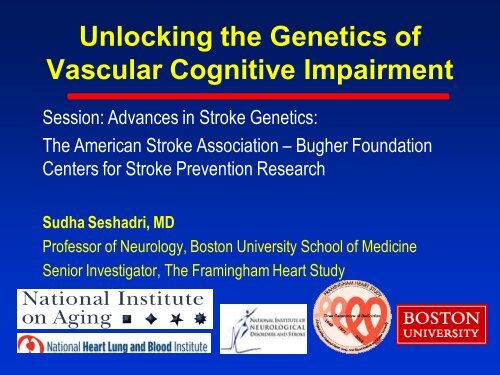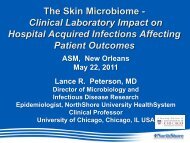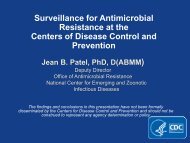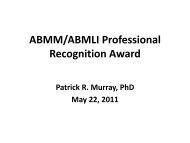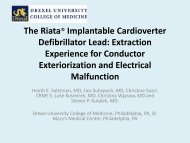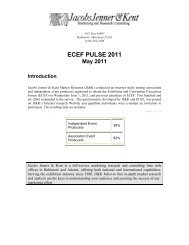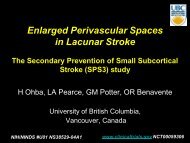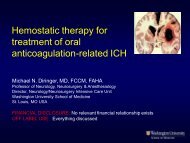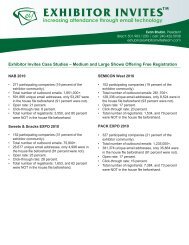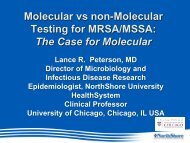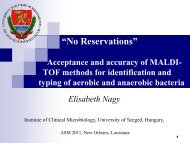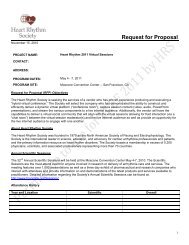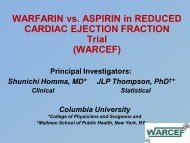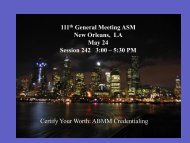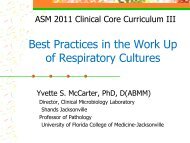Unlocking the Genetics of Vascular Cognitive Impairment
Unlocking the Genetics of Vascular Cognitive Impairment
Unlocking the Genetics of Vascular Cognitive Impairment
You also want an ePaper? Increase the reach of your titles
YUMPU automatically turns print PDFs into web optimized ePapers that Google loves.
<strong>Unlocking</strong> <strong>the</strong> <strong>Genetics</strong> <strong>of</strong><br />
<strong>Vascular</strong> <strong>Cognitive</strong> <strong>Impairment</strong><br />
Session: Advances in Stroke <strong>Genetics</strong>:<br />
The American Stroke Association – Bugher Foundation<br />
Centers for Stroke Prevention Research<br />
Sudha Seshadri, MD<br />
Pr<strong>of</strong>essor <strong>of</strong> Neurology, Boston University School <strong>of</strong> Medicine<br />
Senior Investigator, The Framingham Heart Study
<strong>Vascular</strong> <strong>Cognitive</strong> <strong>Impairment</strong> (VCI)<br />
• Substantial individual risk and public health burden<br />
• 1 in 3 persons aged 65 will develop stroke, dementia<br />
or both<br />
• Proportion <strong>of</strong> all dementia varies: 15-50%<br />
Schrijvers E M et al., Stroke 2012;43:315-319<br />
Skoog I et al., NEJM 1993; 328:153-8.
Outline<br />
• VCI has a genetic basis<br />
• Phenotype remains hard to define<br />
• GWAS approaches<br />
• Candidate Gene approaches<br />
• Next Steps
Stroke and Dementia are Heritable<br />
• Dementia<br />
– (60-80% in twin studies)<br />
• Stroke<br />
– (20-30% in twin studies)<br />
Gatz M et al., Arch Gen Psychiatry 2006<br />
Bak S et al., Stroke 2002<br />
Heritability <strong>of</strong> VaD in FHS ~30% using ADDTC defn.<br />
• Parental dementia impairs <strong>of</strong>fspring verbal memory<br />
• Parental stroke impairs <strong>of</strong>fspring visual memory<br />
Debette et al., Neurology, 2009;73:2071; Weinstein et al., ISC 2012
<strong>Unlocking</strong> <strong>the</strong> <strong>Genetics</strong> <strong>of</strong> VCI<br />
• Improve understanding <strong>of</strong> biology<br />
• Permit more effective, targeted 1ºry and 2ºry prevention<br />
• New preventive, treatment modalities
Approach to <strong>Genetics</strong> <strong>of</strong><br />
<strong>Vascular</strong> <strong>Cognitive</strong> <strong>Impairment</strong><br />
• Define <strong>the</strong> phenotype (s) <strong>of</strong> interest<br />
– ‘<strong>Vascular</strong> Dementia’
Clinical Criteria to Define VaD<br />
• Hachinski Ischemic Score (HIS)<br />
• Diagnostic and Statistical Manual (DSM- III, IIIR, IV) criteria<br />
• International Classification <strong>of</strong> Disease (ICD)-10<br />
• California Alzheimer’s Disease Diagnostic and Treatment<br />
Centers (ADDTC) criteria<br />
• National Institute for Neurological Diseases and Stroke-<br />
Association Internationale pour la Recherche et<br />
‘Enseignement en Neurosciences (NINDS-AIREN) criteria<br />
Κ=0.76
Clinical Criteria for<br />
<strong>Vascular</strong> Dementia<br />
Sensitivity Specificity<br />
DSM-IV 0.5 0.84<br />
ADDTC-possible 0.7 0.78<br />
NINDS-AIREN-possible 0.55 0.84<br />
ADDTC-probable 0.2 0.91<br />
NINDS-AIREN-probable 0.25 0.93<br />
ICD-10 0.2 0.94
VCI: The Inclusive Definition<br />
• <strong>Cognitive</strong> or behavioral problems<br />
• Disease affecting blood vessels or blood flow to<br />
part or all <strong>of</strong> <strong>the</strong> brain<br />
• Evidence <strong>of</strong> damage to part or all <strong>of</strong> brain due to<br />
vascular factors
• <strong>Vascular</strong> Dementia<br />
VCI is Heterogenous<br />
– Following clinical strokes<br />
– Extensive small vessel disease (covert infarcts, WMH)<br />
– Specific arteriopathies<br />
– Amyloid angiopathy & multiple microbleeds<br />
• Contribution <strong>of</strong> vascular factors to AD<br />
• <strong>Vascular</strong> Mild <strong>Cognitive</strong> <strong>Impairment</strong> (VaMCI)
Approach to <strong>Genetics</strong> <strong>of</strong><br />
<strong>Vascular</strong> <strong>Cognitive</strong> <strong>Impairment</strong><br />
• Define <strong>the</strong> endophenotype (s) <strong>of</strong> interest<br />
– ‘<strong>Vascular</strong> Dementia’<br />
– Dementia/<strong>Cognitive</strong> function after Stroke<br />
– <strong>Cognitive</strong> function and decline<br />
– Imaging correlates <strong>of</strong> VCI (MRI infarcts, WMH)<br />
– Neuropathological Indices <strong>of</strong> <strong>Vascular</strong> Brain Injury
Approach to <strong>Genetics</strong> <strong>of</strong> VCI<br />
• May need complementary approaches<br />
• Should persons with AD pathology be included<br />
as cases/ controls/ excluded?
Approach to <strong>Genetics</strong> <strong>of</strong><br />
<strong>Vascular</strong> <strong>Cognitive</strong> <strong>Impairment</strong><br />
• Explore various approaches to gene discovery<br />
– GWAS<br />
– Candidate Genes<br />
– Whole exome, Whole genome & Targeted sequencing<br />
for rare variants<br />
– Mitochondrial Inheritance - Copy Number Variants<br />
– Telomere length - Epigenetics
GWAS Approaches to VCI
A, Genome-wide association plot (Manhattan plot) showing all single-nucleotide<br />
polymorphisms with <strong>the</strong>ir respective chromosome and position on <strong>the</strong> X-axis plotted against<br />
<strong>the</strong>ir association probability value on <strong>the</strong> Y-axis.<br />
Copyright © American Heart Association<br />
Schrijvers E M et al. Stroke 2012;43:315-319
Cohorts for Heart and Aging<br />
Research in Genomic Epidemiology<br />
(CHARGE) Consortium<br />
http://depts.washington.edu/chargeco/wiki/Main_Page
Overview <strong>of</strong> CHARGE<br />
• CVD/Aging cohorts with GWAS data<br />
– ARIC, CHS, AGES, ASPS, FHS and Rotterdam<br />
– PHENOTYPE HARMONIZATION<br />
– Sharing <strong>of</strong> within-study analyses results for crossstudy<br />
prospective meta-analysis<br />
– Imputation to HapMap permitted meta-analyses<br />
despite use <strong>of</strong> different platforms in each study<br />
-- Austrian Study <strong>of</strong> Stroke Prevention (ASPS)
GWAS <strong>of</strong> ‘All dementia’ (AD+ VaD) in CHARGE<br />
Results similar to AD;<br />
Few loci showing stronger associations with all dementia than<br />
AD: e.g. LPL, although this has also been associated with AD
Log 10 (p)<br />
GWAS <strong>of</strong> Covert Brain Infarcts in CHARGE<br />
p = 5 x 10-8<br />
p = 5 x 10-7<br />
Chromosome<br />
MACROD2<br />
FLRT3<br />
Debette S et al., Stroke 2010; 41:210-217.
GWAS <strong>of</strong> White Matter Hyperintensities in CHARGE<br />
N=12,385<br />
17q25: rs3744028, P=4.0x10 -15 ; rs1055129, P=2.6x10 -11<br />
Fornage et al., Ann Neurol. 2011;69:928-939.<br />
TRIM65, TRIM 47, FBF1, WBP2
MYO1B<br />
GWAS <strong>of</strong> <strong>Cognitive</strong> Speed in CHARGE<br />
Trails A<br />
rs11739440<br />
5439 persons, age 45+<br />
Ibrahim et al., Presented at ICAD, Paris, 2011
GWAS <strong>of</strong> <strong>Cognitive</strong> Processing Speed Ability in CHARGE<br />
Digit-Symbol and Letter-Digit Substitution Tests<br />
N=32,900 persons over age 45 in 20 cohorts<br />
chromosome: 11; Location: 11q23<br />
rs12363125<br />
P = 4.72E-007<br />
Ibrahim et al., Presented at ICAD, Paris, 2011<br />
25
Candidate Gene Approaches<br />
to VCI
Candidate Gene Approaches to VCI<br />
• Limited by known biology<br />
• Would not target intergenic regions<br />
• Fewer hypo<strong>the</strong>ses, greater power with smaller<br />
samples
Candidate Gene Approaches<br />
– Genes determining Brain reserve, response to injury<br />
• (APOE, VLDLR, BDNF)<br />
– Stroke genes<br />
– AD genes<br />
– Monogenic disorder genes<br />
• NOTCH3 (CADASIL)<br />
• HTRK1 (CARASIL)<br />
• TREX1 (RVCL) COL4A1 (SVD)
HR <strong>of</strong> 2.3 associated with ≥1 APOE ε4 allele for non-AD dementias.
GWAS <strong>of</strong> Stroke in <strong>the</strong> CHARGE Consortium<br />
Results <strong>of</strong> Tests for <strong>the</strong> Association between Stroke and Each SNP<br />
Ikram M et al. N Engl J Med 2009;10.1056/NEJMoa0900094
Associations in <strong>the</strong> Region Centered on rs11833579 and Containing NINJ2<br />
Ikram M et al. N Engl J Med 2009;10.1056/NEJMoa0900094<br />
Ninjurin-2: Transmembrane protein in<br />
<strong>the</strong> “nerve-injury-induced protein” family
NINJ2 and recurrent stroke, mortality<br />
765 patients with incident ischemic stroke &<br />
977 age-matched community controls<br />
Mean age: 62.8 ± 12.2 yrs<br />
765 cases, 977 community controls, enrolled day <strong>of</strong> stroke<br />
HR Enrolled for combined at outcome 0.89 ± <strong>of</strong> 1.7 recurrent days stroke, after mortality: stroke<br />
2.85 (1.34-6.06); p=0.007<br />
rs12425791 was associated with ischemic stroke<br />
(OR=1.67, 95%CI=1.05-2.66, p=0.031)<br />
TAIWAN STROKE GENETICS CONSORTIUM Hsieh et al., J Biomed Sci 2012
).<br />
Inverse Association with Memory<br />
• NINJ2 (rs11833579 )<br />
– Associated with memory decline (p=9x10 -5 ) &<br />
– With AD susceptibility<br />
– In Religious Orders Study/ Memory and Aging Project<br />
(p=0.001)<br />
– In CHARGE (p=0.02).<br />
Shulman et al., ICAD, 2012
GWAS <strong>of</strong> Stroke<br />
• 2 prior GWAS: 1 did not find any SNP reaching<br />
genome-wide significance<br />
PITX2<br />
• Ano<strong>the</strong>r related an Afib associated SNP to<br />
cardioembolic stroke
Stroke Genes (SNPs) associated with poorer cognitive function<br />
2493 persons with GWAS and cognitive testing in <strong>the</strong> Framingham Study<br />
Trails A and B, Visual Reproductions, Hooper, Verbal Fluency<br />
SNPID chr Gene <strong>Cognitive</strong> Phenotype p-value<br />
rs2200733 4 PITX2 Trails A<br />
Visual memory<br />
Verbal Fluency<br />
rs7193343 16 ZFHX3 Hooper visual organization<br />
Verbal Fluency<br />
0.02<br />
0.03<br />
0.02<br />
0.01<br />
0.04
New Late-Onset AD Genes<br />
• Chr 1: ` CR1: Complement component (3b/4b) receptor 1<br />
• Chr 2: BIN1: Bridging integrator 1<br />
• Chr 6: CD2AP: CD2 associated protein<br />
• Chr 7: EPHA1: Ephrin 1<br />
• Chr 8: CLU/APOJ: Clusterin<br />
• Chr 11: MS4A: membrane-spanning 4-domains, subfamily A, member 4<br />
PICALM: Phosphatidylinositol binding clathrin assembly protein<br />
• Chr 19: APOE/TOMM40/APOC1<br />
• CD33<br />
ABCA7: ATP-binding cassette, sub-family A
AD Genes (SNPs) associated with poorer cognitive function<br />
2493 persons with GWAS and cognitive testing in <strong>the</strong> Framingham Study<br />
Trails A and B, Visual Reproductions, Hooper, Verbal Fluency<br />
SNPID chr Gene <strong>Cognitive</strong><br />
Phenotype<br />
p-value<br />
rs11136000 8 CLU Hooper 0.02<br />
rs744373 2 BIN1 Trails B-A<br />
Visual Memory<br />
0.04<br />
0.02<br />
rs3764650 19 ABCA7 Hooper 0.03
Braskie et al., 2011
Common SNPs in NOTCH3 were associated with WMH<br />
among hypertensives in CHARGE
Approach to <strong>Genetics</strong> <strong>of</strong><br />
<strong>Vascular</strong> <strong>Cognitive</strong> <strong>Impairment</strong><br />
• Explore various approaches to gene discovery<br />
– GWAS<br />
– Candidate Genes<br />
– Whole exome, Whole genome & Targeted sequencing<br />
for rare variants<br />
– Mitochondrial Inheritance - Copy Number Variants<br />
– Telomere length - Epigenetics
Mitochondrial Stroke Genetic Risk Score was also associated with WMHV in 792 persons with MRI
Summary, Next Steps<br />
• A multi-pronged approach will be required using<br />
case-control series & cohorts for genetics <strong>of</strong><br />
– cognitive performance in persons with stroke<br />
– VaD and vMCI defined broadly<br />
– Structural correlates <strong>of</strong> VCI
Summary, Next Steps<br />
• Iterative Process<br />
Molecular<br />
biology,<br />
o<strong>the</strong>r<br />
genes in<br />
pathway<br />
Structural<br />
and<br />
functional<br />
effects<br />
Identify<br />
putative<br />
VCI genes
Framingham Neurology Research Team<br />
• Philip A. Wolf, MD<br />
• Sudha Seshadri, MD<br />
• Rhoda Au, PhD<br />
• Margaret Kelly-Hayes, DEd RN<br />
• Carlos S. Kase, MD<br />
• Sanford F. Auerbach, MD<br />
• Ann McKee, MD<br />
• Ivana Delalle, MD, PhD<br />
• Jose R. Romero, MD<br />
• Zaldy S. Tan, MD<br />
• Aleksandra Pikula, MD<br />
• Stephanie Debette, MD PhD<br />
• Anil Nair, MD<br />
- Anita S. DeStefano, PhD<br />
-Larry D. Atwood, PhD<br />
-Qiong Yang, PhD<br />
- Charles DeCarli, MD<br />
-Angela Jefferson, PhD<br />
-Sherral Devine, PhD<br />
-Lisa Draxler Hankee, PhD<br />
• Alexa S. Beiser, PhD<br />
• Sarah Preis, PhD<br />
• Yulin Lu<br />
• Calvin Lu<br />
• Jayandra Himali<br />
• Linda Farese<br />
• Deb Foulkes<br />
• Lois Abel<br />
Maureen Dunn, Tim Kane, Richard Ahl, Jessica Saurman,<br />
Kristen Knox
Framingham Neurology Research Team<br />
• Philip A. Wolf, MD<br />
• Sudha Seshadri, MD<br />
• Carlos S. Kase, MD<br />
• Sanford F. Auerbach, MD<br />
• Jose R. Romero, MD<br />
• Galit Weinstein, PhD<br />
• Aleksandra Pikula, MD<br />
• Stephanie Debette, MD PhD<br />
• Zaldy Tan, MD<br />
• Rhoda Au, PhD<br />
• Margaret Kelly-Hayes, DEd RN<br />
• Ann McKee, MD<br />
• Ivana Delalle, MD, PhD<br />
-Anita S. DeStefano, PhD<br />
-Qiong Yang, PhD<br />
-Seung Hoan Choi, Jing Wang<br />
- Charles DeCarli, MD<br />
-Sherral Devine, PhD<br />
-Lisa Draxler Hankee, PhD<br />
And <strong>the</strong> wonderful participants <strong>of</strong> <strong>the</strong> Framingham Heart Study<br />
• Alexa S. Beiser, PhD<br />
• Sarah Preis, PhD<br />
• Jayandra Himali<br />
• Yulin Lu<br />
• Calvin Lu<br />
• Linda Farese<br />
• Deb Foulkes<br />
• Lois Abel<br />
Maureen Dunn, Tim Kane, Richard Ahl, Hea<strong>the</strong>r Pironti,
AGES-Reykjavik: Lenore Launer, Albert V. Smith, Vilmundur Gudnason, Gudny<br />
Eiriksdottir, Tamara Harris<br />
A<strong>the</strong>rosclerosis Risk in Communities Study: Thomas Mosley, Myriam Fornage, Eric<br />
Boerwinkle, Jan Bressler<br />
Austrian Study <strong>of</strong> Stroke Prevention: Reinhold Schmidt, Helena Schmidt, Katja-<br />
Elisabeth Petrovic, Franz Fazekas, Margherita Cavalieri<br />
Cardiovascular Health Study: Josh Bis, Will Longstreth, Annette Fitzpatrick, Oscar<br />
Lopez, Bruce Psaty, Thomas Lumley, James Becker, Jerome Rotter, Erin Wallace<br />
ERF: Cornelia van Duijn, Maaike Schuur, Carla Ibrahim<br />
Framingham Heart Study: Philip Wolf, Anita L. DeStefano, Stephanie Debette, Qiong<br />
Yang, Charles DeCarli, Alexa Beiser, Rhoda Au, Galit Weinstein, Aleksandra Pikula<br />
Rotterdam Study: Cornelia van Duijn, M. Arfan Ikram, Ben Verhaaren, Carla Ibrahim,<br />
Aad Van der Lugt, Renee van de Brujn, Monique Breteler<br />
Collaborating Studies: EUROSPAN, LBC, Health ABC, 3C study, ROS/MAP, WHICAP,<br />
TASCOG, Group Health, EADI, GERAD, ADGC, ISGC and METASTROKE, NHS,<br />
SMA, Hunter, BLSA, Fundació ACE, PROSPER, Generation Scotland, AAA, GEMS,<br />
GENOA, NOMAS, SHIP


